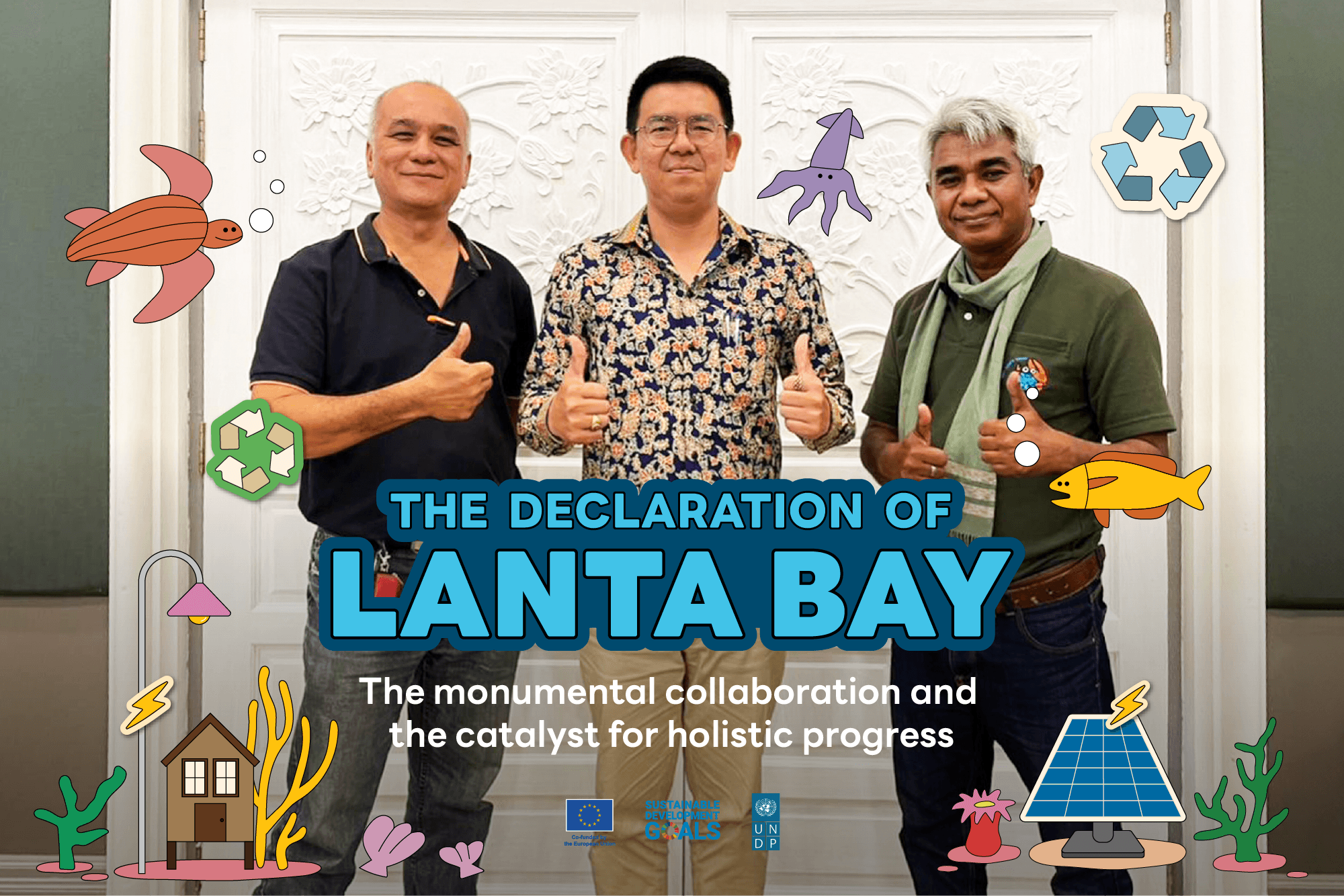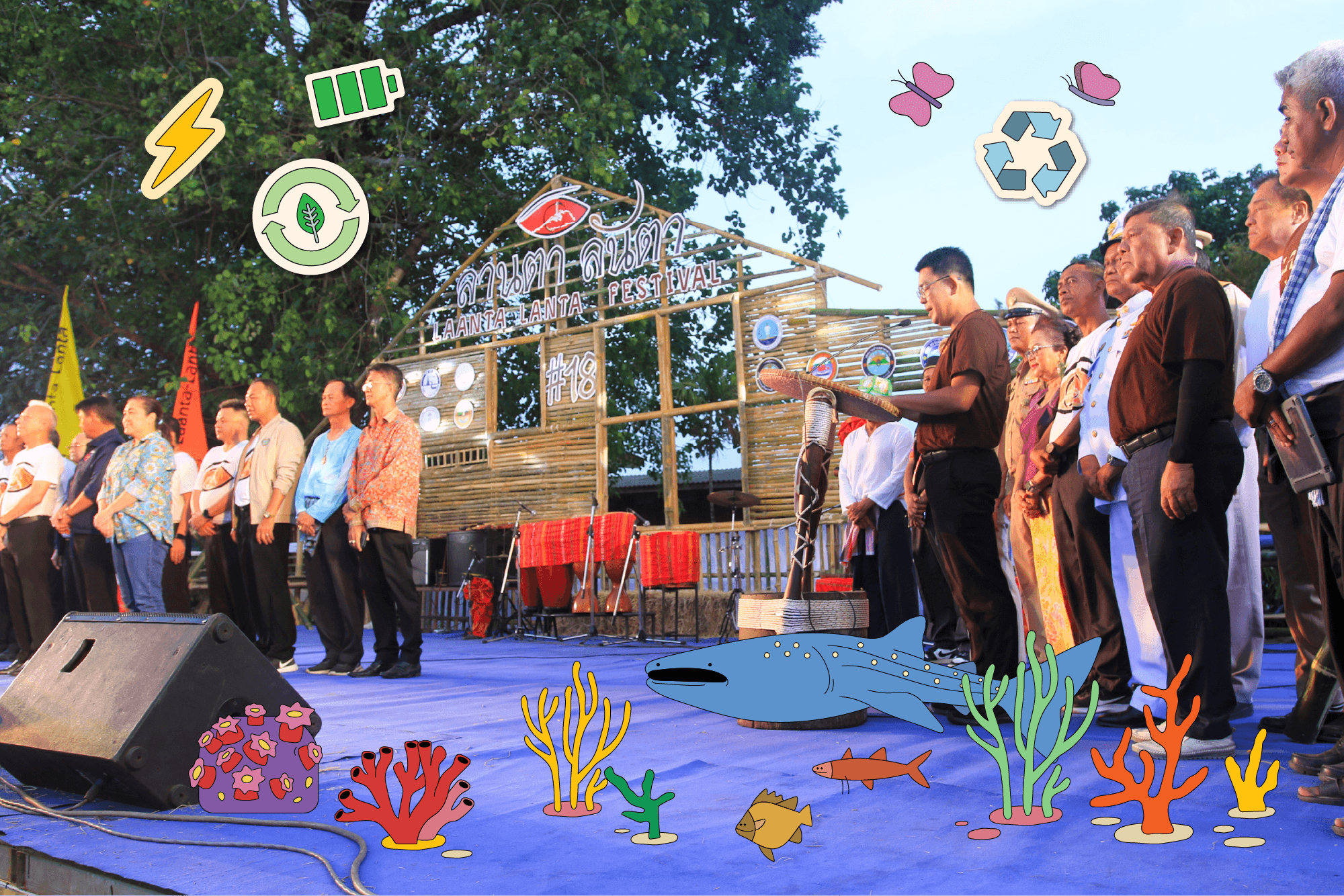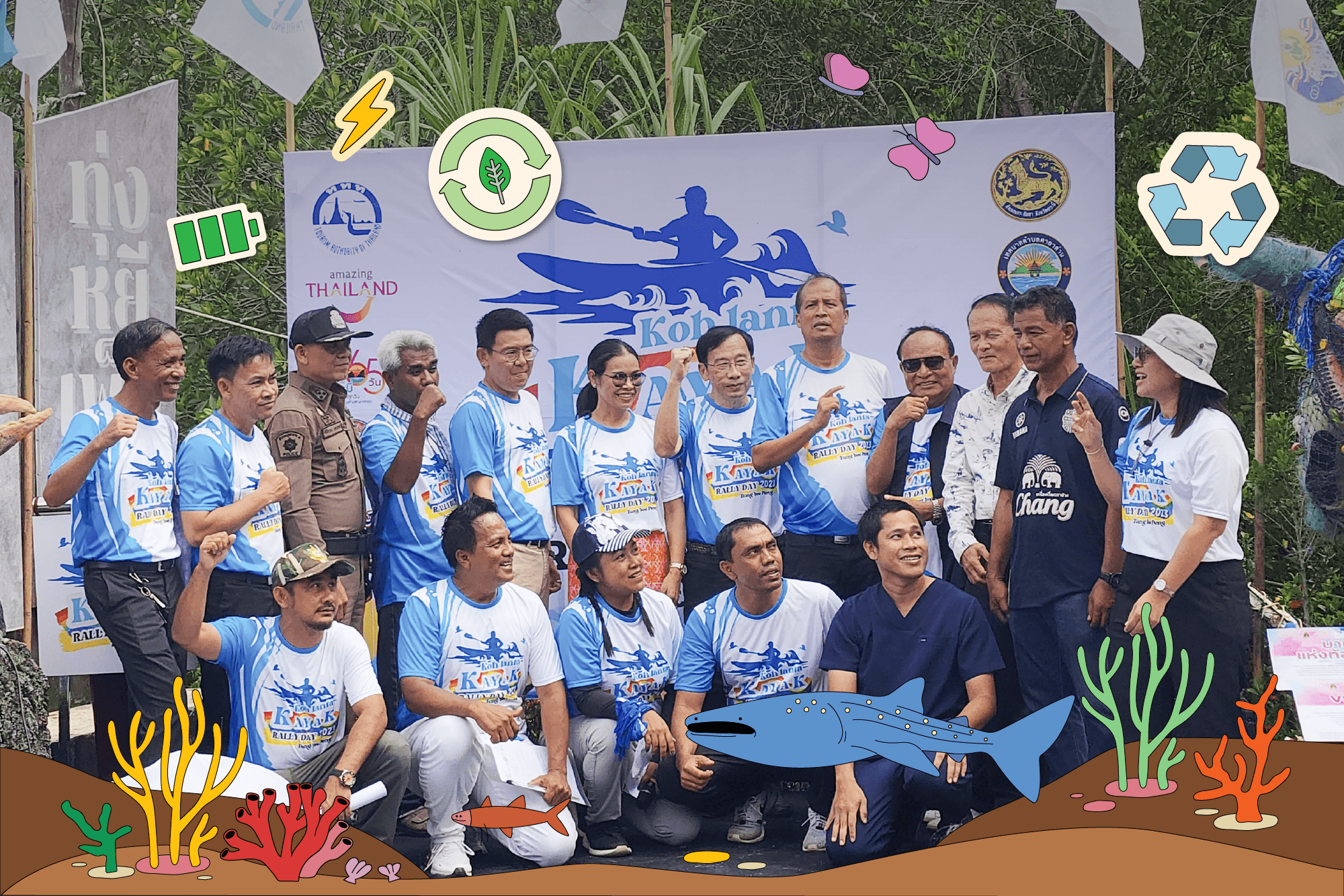‘The Declaration of Lanta Bay,’ the islanders' monumental collaboration and the catalyst for the uplifting atmosphere of holistic progress.
December 6, 2023

Once upon a time in Lanta, an archipelago located south of Krabi province, two boys were born and grew up on the island.
The Lanta district covers an area of 220,000 rai and consists of 53 islands. Among them, six serve as the residences of islanders, with Ko Klang, Ko Lanta Noi, and Ko Lanta Yai being the three primary islands.
The two boys provided insights into their community's history. In earlier times, Lanta was a peaceful community, abundant with seas, forests, food, and seedlings. The primary mode of transportation for locals was through waterways. As an archipelago distant from the mainland, many communities relied on rice farming, leading to rice fields scattered across the islands. Despite diverse ethnicities and religions—including Buddhists, Muslims, Thais, Chinese, and sea gypsies—the inhabitants coexisted harmoniously. From 1987 onward, Lanta transformed into a tourist destination, ushering in rapid changes.
Both children grew up to take on important roles for their fellow islanders.
The first was Teerapoch ‘Oh’ Kasirawat, the advisor for both the Ko Lanta Tourist Association and the Krabi Province Community-Based Tourist Association. The second individual was Narathon Hongthong, holding the position of vice president of the Krabi Province Community-Based Tourist Association.
"I was drawn to tourism work for various reasons, but primarily, I want to lead a joyful life in my hometown," expressed Narathon. One of his notable accomplishments was spearheading the development of Community Enterprises Development for Ecotourism in Thung Yi Pheng, a small community on Ko Lanta Yai.
"If our hometown is destined to encounter turmoil and competition in the future, our sunset years will be deprived of joy, prompting many to sell their lands and relocate elsewhere."
"These are the concerns I harbor for my island," Narathon said with a smile.
Narathon explained that over time, ownership of the land shifted. The paddy fields once used for local rice farming were converted into shrimp farms, marking the end of Ko Lanta's era of local rice cultivation.
The economic landscape of Ko Lanta transformed with the arrival of tourism. Many shifted away from agriculture to tourism business. Nonetheless, Teerapoch cautioned against exclusively depending on tourism as the primary source of income for Lanta. Doing so, he emphasized, could lead to inequality, with those outside the tourism business left with no opportunities before contributing to a high rate of poverty.
Instead, a suitable policy should stimulate the overall growth of the city, promoting a high quality of life for Lanta islanders and generating inherent value for the city.
After an extended period of working in tourism in other regions, Narathon returned to develop his hometown in 2002, with a focus on developing local agriculture and trade, supplemented by tourism.
"When my mother first relocated here, her relatives only saw hardship. For government officials, moving to Lanta seemed like a form of punishment," Teerapoch remarked.
From an external viewpoint, Lanta was not a place of comfort.
"However, Lanta has transformed into a city of opportunities through tourism today. If we do not seize these opportunities and let the city's development unfold without proper guidance, these opportunities will be lost. Before we know it, we might find ourselves in a city plagued by pollution and chaos. Effective management is crucial for developing a good city."
"As we take initiatives, those who share our vision will emerge, and with their skills, unite to connect people within and beyond the region."
A pivotal factor is the government initiative to build a 2-kilometer bridge linking the Ko Klang district side of Ko Lanta to Ko Lanta Noi district. The completion of this bridge is expected to accommodate a substantial number of tourists, thereby enhancing the local economy. However, it also necessitates increased attention to the oversight of natural resources, environmental concerns, and the preservation of the local way of life.
Lanta residents unanimously agreed that the city should formulate its development policy 4-5 years prior to the completion of the bridge.
Fortunately, Lanta is home to numerous enthusiastic individuals, such as Nopparat Sriprom, the new district chief officer of Lanta, who are brimming with passion and fully aware of the bridge construction. They agree that it is an opportune time for Ko Lanta to establish an 'instrument' to effectively manage sustainability across social, economic, and environmental sectors.
As of April 25, 2023, 'The Declaration of Lanta Bay' has been formally declared.
Bringing about changes is no simple feat, yet Lanta manages to make it happen.
Lanta is already an operating ground for numerous organizations. Teerapoch underscored the district chief officer's strategic planning as his strength, exemplified by the implementation of an "organizing discussion forum." This forum extended invitations to sectors including the local population, local organizations, academics, and NGOs, promoting inclusivity and information distribution. In the end, a total of 48 organizations collaborated in formulating the declaration.
The Declaration comprises 9 goals in total.
1. Sustainable fisheries
2. Preservation of coastal and marine resources
3. Development of a green economy and collaborative economy
4. Sustainable tourism
5. Economy inclusive to the local community
6. Reduction of harmful effects from microplastic and plastic waste in the marine environment
7. Improvement of energy consumption efficiency and transition from fossil power to clean energy
8. Social development and quality of life
9. Promoting inclusive participation
In fact, Ko Lanta had undergone many developments across various sectors before. Nevertheless, the declaration stands as a proclamation that fosters a collaborative atmosphere and raises awareness for a shared understanding of Lanta's development directions.
Lanta means business this time.

At the heart of the declaration lies environmental concerns, particularly on 'waste,' addressing the initial challenges that Lanta faced with an overflowing landfill.
Effective waste management is crucial. Contaminated waste, lacking a proper disposal system, can lead to the spread of contaminants. Likewise, improper management of toxic waste poses hazards. The overflow of landfills contributes to the accumulation of pollution in areas, causing water and soil contamination, with subsequent implications for human health.
Lanta’s waste originates from three sources: community waste, tourism-related waste, and debris from the sea during storms. Thanks to the support of the Thailand Environment Institute, all these sources have been managed effectively.
The three individuals interviewed provided insights into Lanta's various countermeasures. Lanta adopts a "bin-less society" model that promotes waste sorting at its source to guarantee proper waste disposal. Educational sessions were conducted in 36 villages, contributing to a decline in the dengue fever rate. Waste stations were set up during community events, and Lanta Plus centers upcycled bottle caps into various products. Collaborative agreements were established between hotels/restaurants and chicken/duck farms to distribute leftover food. Noteworthy initiatives include partnerships with recycling companies such as Wongpanit and the creation of the Lanta group, which purchases antiques.
"Unregulated waste dumping stimulates the production of invisible microplastics which later find their way into forests and mountains before rainwater transports them to pollute water sources."
"In the past, waste management measures were handled individually by each local sector, lacking a unified strategy for the entire city. The Declaration of Lanta Bay brings awareness to potential future issues, fostering a collaborative effort among the various sectors."
The pursuit of health improvement aligns with SDG 3 on the promotion of healthy lives and well-being for all and SDG 6 on sustainable management and sanitation.

Lanta was equally persistent in improving the quality of life and addressing the four requisites.
Regarding housing, Lanta partnered with the Community Organizations Development Institute (Public Organization) for the Ban Mankong project (Stable Housing) in Baliu, providing 89 homes and outlining plans for the Ban Po Piang (Sufficiency Housing) project.
Both initiatives aim to address housing needs for low-income individuals across various communities, from the renovation of disrepair homes and the construction of new houses to replace old ones. This involves designing village plans to improve living quality. The success of all these efforts hinges on the collaboration of local communities as the driving force to establish sustainable development for the future.
Concerning health and well-being, the hospital was moved to the central area of the island to improve accessibility to public healthcare.
"In the past, over 20,000 villagers had to take a car ferry and then endure an approximately 30-kilometer car ride to reach the hospital. We have come a long way since then," recalled the district chief officer. This aligns with the pursuit of SDG 11 to establish sustainable human settlement as well.
Additionally, ophthalmologists were arranged to conduct eye examinations for the villagers. Given Lanta's exposure to sunlight and wind, there is a prevalence of eye issues among children, while adults commonly face glaucoma and cataracts. This is a problem that cannot be overlooked.
“About careers, we explore ways for the tourism sector to generate income for the general population rather than the capitalist group. Therefore, we have embraced community-based tourism as our city's strategy." They also initiated the production of community products, developed local fisheries, and collaborated on collective bargaining to enhance their negotiation capabilities.
When asked about the sustainable utilization of marine resources in alignment with SDG 14, the district chief officer affirmed that, with its encouraging atmosphere of preservation and sustainability, the Declaration of Lanta Bay has substantially motivated everyone to adhere to fisheries laws and regulations.
Teerapoch added that the Declaration of Lanta Bay connects grassroots people with tourism, particularly in the management of marine resources. Given Lanta's identity as a city of ocean tourism, effective management of marine resources for sustainable use is integral to fostering sustainable tourism.
"Fortunately, the southern provinces have the Community Organizations Development Institute, which assists in connecting local fishery communities, forming preservation communities spanning many areas in the southern region," continued Teerapoch. The advancement of fisheries also aligns with SDG 12 which involves sustainable consumption and production as well.

As mentioned earlier, Lanta is home to diverse nationalities and ethnicities. The island boasts the largest population of Urak Lawoi in Thailand who coexist harmoniously with other ethnic groups. The district chief officer pointed out that, in fact, the Urak Lawoi might be the first ethnic group to have settled in the Lanta archipelago 400 years ago, 122 years prior to the establishment of the district government.
The Urak Lawoi have an affinity with the sea; they know the watercourses that have corals and sea fans, and they know which watercourses are best for trawling nets. Lanta has adopted this expertise as a model for ethnic tourism. Moreover, Mahidol University has initiated the study of the Urak Lawoi language, recording it for preservation purposes.
"We made efforts to promote and incorporate the Urak Lawoi in every aspect of the city's planning. The Urak Lawoi community is also one of the groups that signed the Declaration of Lanta Bay," stated the district chief officer.
Lanta’s activities are in accordance with the UN’s 2030 Sustainable Development Goals which support the inclusion of indigenous people and prevent discrimination.

How was the response from the residents of Lanta?
"At first, the people of Lanta expressed concerns about the Declaration of Lanta Bay, fearing it might impose various restrictions. However, after participating in numerous discussions on soft power and collaborative declarations of intent, those with a comprehensive understanding have agreed to provide more cooperation," replied the district chief officer. Teerapoch continued:
Lanta can be considered a model city that garners cooperation from every sector, aligning with SDG 17, which underscores the strengthening and revitalization of global partnerships.
"Other regions in Thailand can undertake similar endeavors as well," he mentioned, referring to other individuals who aspire to improve their hometowns. "By examining our surrounding environment, we will find that there are resource hubs in every part of Thailand that, when elevated, can contribute to sustainability."
"When a community achieves a certain level of sustainability, and neighboring communities follow suit, the impact will be amplified at the district, provincial, and regional levels, ultimately culminating in the sustainability of the entire country."
"Many are skeptical until they actively engage in it. Once you get involved firsthand, your perspective deepens, and eventually, you'll be able to envision sustainability in the future on your own."
"What is your vision for an ideal world?" - The question was directed at the district chief officer, originally from Nakhon Ratchasima, who now undertakes the mission of developing Lanta, even though it is not his hometown.
"In my ideal world, everyone collaborates to find solutions, and ownership is shared by all. This collective effort would truly create a significant impact, triggering the Butterfly Effect."

 Locations
Locations


